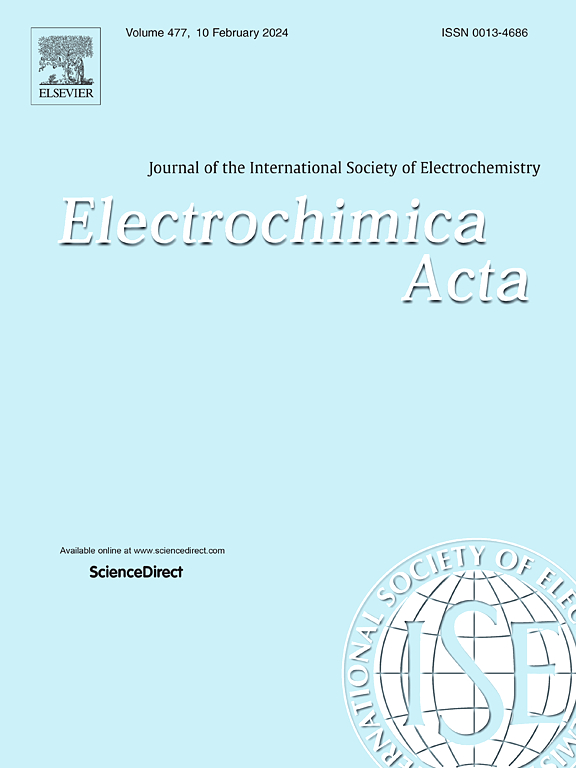Adsorption and electrocatalytic properties of polysulfides by Ni-N coordination structures
IF 5.6
3区 材料科学
Q1 ELECTROCHEMISTRY
引用次数: 0
Abstract
In the field of energy storage, lithium-sulfur batteries are considered a highly promising energy storage technology due to their exceptional theoretical energy density. However, the "shuttle effect" of lithium polysulfides (LiPSs) and the sluggish redox kinetics of the sulfur cathode have hindered their commercialization. Addressing these challenges, this study successfully anchored Ni single atoms on N-Doped Hollow Carbon Spheres (Ni-NHCS) via a one-step impregnation method, fabricating an efficient sulfur carrier material. The Ni single atoms in Ni-NHCS form highly chemically active Ni-N coordination structures with nitrogen atoms, significantly enhancing the chemical adsorption capacity for LiPSs and effectively facilitating their conversion reactions. Experimental results and theoretical calculations both confirm the strong interaction between Ni-NHCS and LiPSs, thereby improving the utilization rate of sulfur and the electrochemical performance of the battery. Moreover, the hollow carbon sphere structure not only enhances the conductivity of sulfur but also effectively suppresses volume expansion during charge-discharge processes. Consequently, lithium-sulfur batteries with Ni-NHCS as the sulfur carrier material exhibit outstanding electrochemical performance, achieving a high specific capacity of 1316 mAh g-1 at a current density of 0.2 C; even at a high current density of 2 C, it can still provide a stable output of 697 mAh g-1. More impressively, after 2850 cycles under 2 C conditions, the capacity fade rate is only 0.027 %, demonstrating excellent cyclic stability. By effectively suppressing the "shuttle effect" and optimizing redox kinetics, this study provides a new strategy for enhancing the performance of lithium-sulfur batteries. These findings not only validate the high-efficiency application potential of carbon-supported metal single-atom catalysts in sulfur cathode materials but also offer new insights for advancing lithium-sulfur battery technology and achieving sustainable, efficient energy storage solutions.
Ni-N配位结构对多硫化物的吸附和电催化性能
在储能领域,锂硫电池因其优异的理论能量密度被认为是一种极具发展前景的储能技术。然而,锂多硫化物(LiPSs)的“穿梭效应”和硫阴极缓慢的氧化还原动力学阻碍了其商业化。为了解决这些问题,本研究通过一步浸渍法成功地将Ni单原子固定在n掺杂空心碳球(Ni- nhcs)上,制备了一种高效的硫载体材料。Ni- nhcs中的Ni单原子与氮原子形成高度化学活性的Ni- n配位结构,显著增强了LiPSs的化学吸附能力,有效促进了它们的转化反应。实验结果和理论计算都证实了Ni-NHCS与LiPSs之间的强相互作用,从而提高了硫的利用率和电池的电化学性能。此外,空心碳球结构不仅提高了硫的导电性,而且有效地抑制了充放电过程中的体积膨胀。因此,以Ni-NHCS为硫载体材料的锂硫电池表现出优异的电化学性能,在电流密度为0.2 C时可达到1316 mAh g-1的高比容量;即使在2℃的高电流密度下,它仍然可以提供697毫安时的稳定输出。更令人印象深刻的是,在2℃条件下循环2850次后,容量衰减率仅为0.027%,表现出优异的循环稳定性。通过有效抑制“穿梭效应”和优化氧化还原动力学,本研究为提高锂硫电池性能提供了新的策略。这些发现不仅验证了碳负载金属单原子催化剂在硫正极材料中的高效应用潜力,而且为推进锂硫电池技术和实现可持续、高效的储能解决方案提供了新的见解。
本文章由计算机程序翻译,如有差异,请以英文原文为准。
求助全文
约1分钟内获得全文
求助全文
来源期刊

Electrochimica Acta
工程技术-电化学
CiteScore
11.30
自引率
6.10%
发文量
1634
审稿时长
41 days
期刊介绍:
Electrochimica Acta is an international journal. It is intended for the publication of both original work and reviews in the field of electrochemistry. Electrochemistry should be interpreted to mean any of the research fields covered by the Divisions of the International Society of Electrochemistry listed below, as well as emerging scientific domains covered by ISE New Topics Committee.
 求助内容:
求助内容: 应助结果提醒方式:
应助结果提醒方式:


